|
Chevrolet HHR
Debut: 2005
Maker: General Motors
Predecessor: no |
|
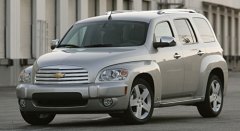 Apparently,
Chevrolet HHR is a carbon copy from Chrysler PT Cruiser. Seeing the
success of the Chrysler retro yet practical hatchback, GM's product
director Bob Lutz decided to copy the successful formula of PT Cruiser.
He won't admit that of course. Instead, he said the styling resembles
the classic '49 Chevy Suburban while the name HHR stands for Heritage
High Roof - what a silly name. Apparently,
Chevrolet HHR is a carbon copy from Chrysler PT Cruiser. Seeing the
success of the Chrysler retro yet practical hatchback, GM's product
director Bob Lutz decided to copy the successful formula of PT Cruiser.
He won't admit that of course. Instead, he said the styling resembles
the classic '49 Chevy Suburban while the name HHR stands for Heritage
High Roof - what a silly name.
With an annual sales targeted at 60,000 units (that's just half of the
PT) and an affordable price from US$16,000 to US$21,000 when all
options are ticked, the Chevrolet HHR cannot afford a dedicated
platform. In fact, it is a derivative of the Delta platform that
already gave birth to Chevrolet Cobalt and Saturn Ion. This is a rather
rigid platform, with strut and torsion-beam suspensions. Power comes
from the familiar 143 hp 2.2-litre Ecotec 16V or 172 hp 2.4-litre
version. Transmission are the predictable 5-speed manual or 4-speed
auto.
On the road, the HHR is rather slow because it is some 200 kg heavier
than a Honda Civic. The rich torque of the 2.4-litre four-pot engine
compensates, but it still needs to rev hard and therefore generate more
noise than desired. In terms of handling and ride, the HHR has a
similar story. The Delta platform provides a fundamentally safe
(understeering) and easy driving character, the suspensions are
compliant and the cabin well insulated from road noise. However, keen
drivers is better to choose a regular sedan or hatchback because the
HHR's High Roof, Heritage or not, results in very high center of
gravity, hence a lot of roll and truck-like cornering behaviour.
Besides, the electric power steering is too light and lack of feel. In
addition to the poor braking power from the rear drum brakes, its
handling can earn no more than 2 stars out of five.
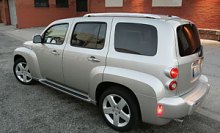 Perhaps
the strongest aspect is how it looks. In my opinion the HHR looks
prettier than the PT, though I would say retro theme is never my cup of
tea. One thing cannot be denied: the HHR has a more upmarket feel in
its cabin construction and materials, having none of the cheap
plasticky feel of the PT. Space-wise, it is not as spacious as PT,
especially rear legroom, but its rear seat can fold flat to form a big
cargo loading area. The boot also got a movable parcel shelf. However,
both cars are not real people carriers, neither as spacious nor as
flexible as European Multi-Activity Vehicles. Perhaps
the strongest aspect is how it looks. In my opinion the HHR looks
prettier than the PT, though I would say retro theme is never my cup of
tea. One thing cannot be denied: the HHR has a more upmarket feel in
its cabin construction and materials, having none of the cheap
plasticky feel of the PT. Space-wise, it is not as spacious as PT,
especially rear legroom, but its rear seat can fold flat to form a big
cargo loading area. The boot also got a movable parcel shelf. However,
both cars are not real people carriers, neither as spacious nor as
flexible as European Multi-Activity Vehicles.
GM took 5 and a half years to reproduce a Chrysler PT Cruiser, yet the
car does not handle or accelerate as good as its benchmark, nor did it
break any new area in packaging. More crucially, being an imitator, it
won't have the original image as the PT Cruiser. Bob Lutz wins no
applause this time.
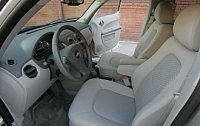 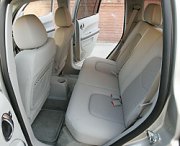 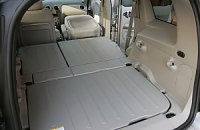 |
| The
above report was last updated on 21 Sep
2005. All Rights Reserved. |
HHR SS
|
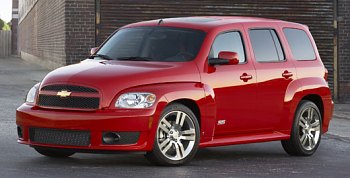
|
Chrysler PT Cruiser Turbo has never
been a success. Can Chevrolet HHR SS break new ground ?
|
As
American no longer fascinate with small sports cars these days, car
makers switch to build more hot hatches. Hot hatches provide good
performance and driving fun without compromising practicality. They are
also cheaper to develop and build than dedicated sports cars. However,
not many American car makers get the know-how to build good hot
hatches. Chrysler group, for example, failed with its PT Cruiser Turbo
and Caliber SRT4. General Motors is also following its footprints with
Chevrolet HHR SS.
Basically, this car is the HHR meets Pontiac Solstice GXP's 260 hp
2.0-liter 16V direct-injection VVT turbocharged engine. When mated with
5-speed manual gearbox it is capable to go from zero to 60 mph in 6.3
seconds. With 4-speed automatic, its engine is limited to 235 hp to
avoid damaging the gearbox, thus 0-60 mph acceleration is slower at 7.5
seconds. Nobody will complain it for being slow, but a sluggish
throttle response means this is not the most inspiring turbocharged
four-cylinder engine on the market, no matter how sophisticated it
looks on paper.
In the Solstice sports car, the engine is mounted longitudinally to
drive the rear wheels. In HHR SS, it is transversely mounted and drives
the front wheels. Like many cost-conscious hot hatches, the front axle
does not have any limited-slip differential, but Chevy fine tuned the
suspension geometry, springs, dampers, anti-roll bars, bushings,
steering knuckle, employs a quicker steering rack and cleverer traction
control. As a result, torque steer and wheel spin are largely
eliminated and the car corners more agile than you might imagined.
Chevy even
claims it lapped Nurburgring in 8 min 44 sec, the best of its class...
Obviously, Chevy classified it into a minivan and ignored all its
possible hot hatch rivals. The problem is, in terms of functions and
accommodation, the HHR SS is closer to a hot hatch than a minivan. By
the standard of hot hatches, it rolls too much in corners and feels too
bulky in the twisty. Moreover, its funny appearance is totally
irrelevant to the performance image. Therefore I really doubt how many
customers it will get. |
| The
above report was last updated on 27 Dec
2007. All Rights Reserved. |
|
|